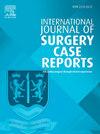腮腺多形性腺瘤引起的巨大高级别癌1例
IF 0.7
Q4 SURGERY
引用次数: 0
摘要
多形性腺瘤可恶性转化为癌前多形性腺瘤(exexomorphic adenoma, CXPA)。由于其与良性肿瘤的相似性,CXPA的诊断具有挑战性。手术切除是主要治疗方法,高危病例推荐辅助放疗。尽管CXPA具有侵袭性,但广泛的手术可能并不总是可行的,特别是在有颈部解剖禁忌的情况下。病例介绍:一名69岁女性,20年缓慢生长的口腔肿块病史,在过去4个月内迅速扩大。影像学和活检证实高级别CXPA,手术时仔细解剖以保留面神经功能。肿瘤大小为24 × 18 × 15 cm,未见神经周围及淋巴血管浸润。患者接受辅助放疗,12个月无病,保留面神经功能。本病例强调了处理大CXPA肿瘤的挑战,特别是在手术中保持神经功能。组织学检查无神经周围浸润提示预后良好,术后放疗可显著降低复发风险。虽然选择性颈部清扫通常适用于高级别CXPA,但由于该患者的身体状况,该手术是禁忌的。结论肺外炎虽具有侵袭性,但不需大面积切除或牺牲神经即可治疗。在颈部解剖不可行的情况下,放射治疗是有效的治疗方法。未来对CXPA的遗传基础和靶向治疗的研究对于提高这种复杂恶性肿瘤患者的个性化治疗策略和改善预后至关重要。本文章由计算机程序翻译,如有差异,请以英文原文为准。
Enormous high-grade carcinoma arising from a pleomorphic adenoma in the parotid gland: A case report
Introduction
Pleomorphic adenomas can undergo malignant transformation into carcinoma ex pleomorphic adenoma (CXPA). CXPA is challenging to diagnose due to its resemblance to benign tumors. Surgical excision is the primary treatment, with adjuvant radiotherapy recommended for high-risk cases. Despite the aggressive nature of CXPA, extensive surgery may not always be feasible, especially in cases with contraindications for neck dissection.
Presentation of case
A 69-year-old female with a 20-year history of a slowly growing buccal mass presented with rapid enlargement over the last four months. Imaging and biopsy confirmed high-grade CXPA, and surgery was performed with careful dissection to preserve facial nerve function. The tumor measured 24 × 18 × 15 cm, and no perineural or lymphovascular invasion was detected. The patient received adjuvant radiotherapy and remained disease-free at 12 months, with preserved facial nerve function.
Discussion
This case highlights the challenges of managing large CXPA tumors, particularly in preserving nerve function during surgery. The absence of perineural invasion in histological findings suggested a favorable prognosis, and postoperative radiotherapy significantly reduced the recurrence risk. While elective neck dissection is generally indicated in high-grade CXPA, it was contraindicated in this patient due to her medical condition.
Conclusion
CXPA, despite its aggressive nature, can often be managed without extensive resection or nerve sacrifice. In cases where neck dissection is not feasible, radiotherapy can be an effective treatment. Future research into the genetic basis and targeted therapies for CXPA is essential to enhance personalized treatment strategies and improve outcomes for patients with this complex malignancy.
求助全文
通过发布文献求助,成功后即可免费获取论文全文。
去求助
来源期刊
CiteScore
1.10
自引率
0.00%
发文量
1116
审稿时长
46 days

 求助内容:
求助内容: 应助结果提醒方式:
应助结果提醒方式:


